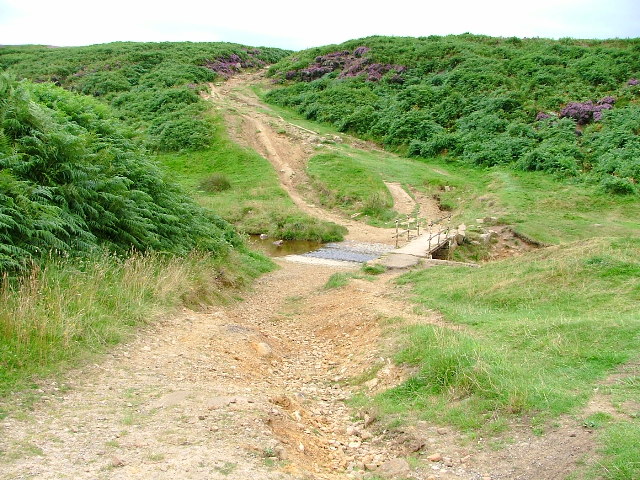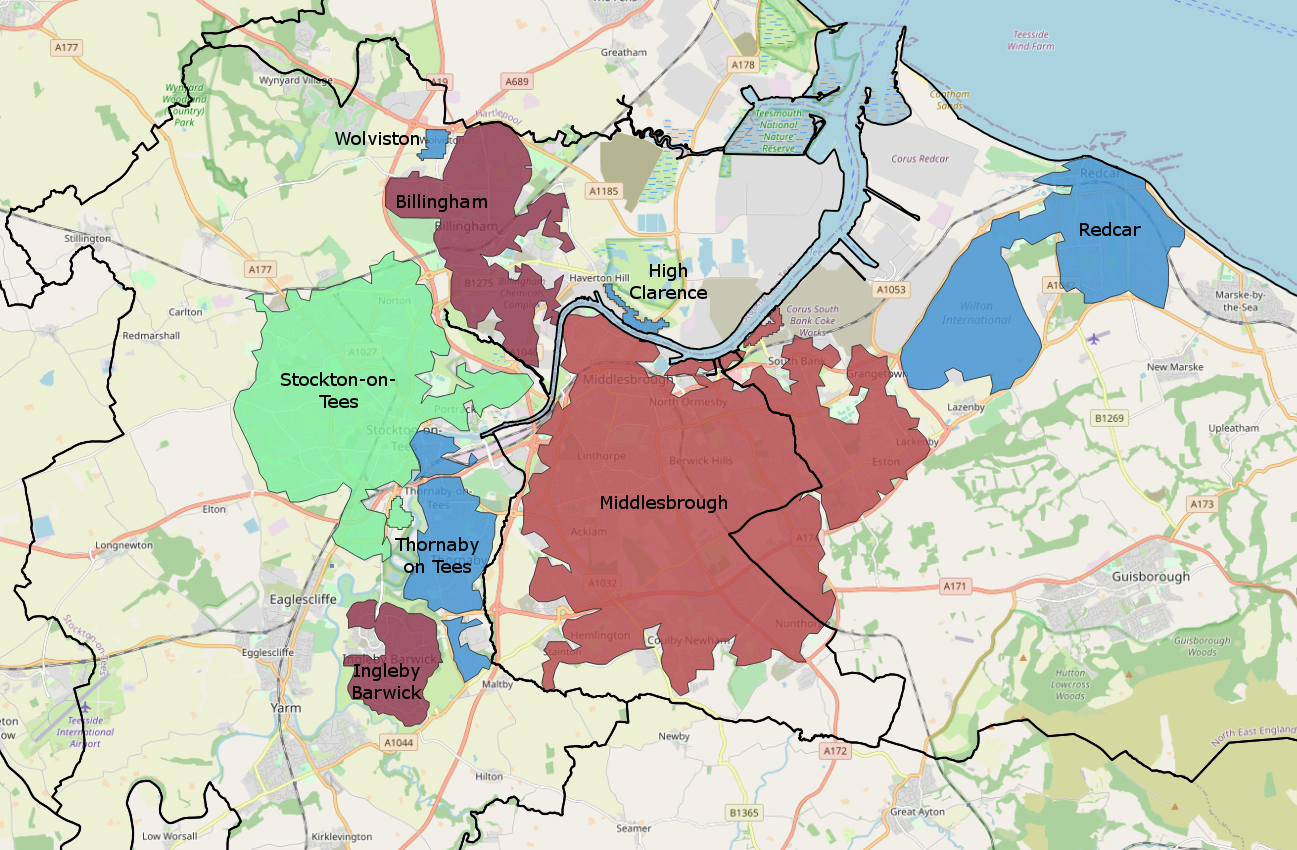|
Cod Beck Reservoir
Cod Beck Reservoir is a man-made lake situated within the North York Moors National Park and near the village of Osmotherley in the English county of North Yorkshire. The reservoir is named after Cod Beck, which is the small river that fills it. History The building of the reservoir was started in 1948 with final completion in 1953. The dam head height is listed as being and an old pit at Crathorne was re-opened in 1950 to supply clay to line the dam head. The treatment works was closed down in 2006 after the deterioration of the quality of the water from the moorland and the presence of Cryptosporidium; water is now supplied to Northallerton and Thirsk, and to Osmotherley village, from Thornton Steward Reservoir. Cod Beck Reservoir now operates as a compensation reservoir to maintain flow into the downstream reaches of Cod Beck and as such, it is still operated and maintained by the local water company. The reservoir is surrounded by woodland and just upstream is the l ... [...More Info...] [...Related Items...] OR: [Wikipedia] [Google] [Baidu] |
North Yorkshire
North Yorkshire is the largest ceremonial counties of England, ceremonial county (lieutenancy area) in England, covering an area of . Around 40% of the county is covered by National parks of the United Kingdom, national parks, including most of the Yorkshire Dales and the North York Moors. It is one of four counties in England to hold the name Yorkshire; the three other counties are the East Riding of Yorkshire, South Yorkshire and West Yorkshire. North Yorkshire may also refer to a non-metropolitan county, which covers most of the ceremonial county's area () and population (a mid-2016 estimate by the Office for National Statistics, ONS of 602,300), and is administered by North Yorkshire County Council. The non-metropolitan county does not include four areas of the ceremonial county: the City of York, Middlesbrough, Redcar and Cleveland and the southern part of the Borough of Stockton-on-Tees, which are all administered by Unitary authorities of England, unitary authorities. ... [...More Info...] [...Related Items...] OR: [Wikipedia] [Google] [Baidu] |
Cod Beck, North Yorkshire
Cod Beck is a river in North Yorkshire, England. It has a catchment area of . The river extends for from above Cod Beck Reservoir at Osmotherley on the edge of the North York Moors through Thirsk and on to join the River Swale at Topcliffe. Cod Beck has a long history of flooding Thirsk and a feasibility study completed in April 2005 recommended additional flood defences and upstream storage. In 2011, a proposed flood defence scheme in Thirsk was cancelled due to the Environment Agency having its budget cut by 41%. The name Cod Beck is a derivative of Cold Beck, where beck is smaller than a river; the stream runs deep between banks, so is always fairly cool. Cod fish are not found in fresh water. Settlements ''from source'' * Osmotherley *Ellerbeck * Foxton *Kirby Sigston *Thornton-le-Street *North Kilvington *South Kilvington *Thirsk * Sowerby *Dalton Dalton may refer to: Science * Dalton (crater), a lunar crater * Dalton (program), chemistry software * Dalton (u ... [...More Info...] [...Related Items...] OR: [Wikipedia] [Google] [Baidu] |
North York Moors
The North York Moors is an upland area in north-eastern Yorkshire, England. It contains one of the largest expanses of Calluna, heather moorland in the United Kingdom. The area was designated as a national parks of England and Wales, National Park in 1952, through the National Parks and Access to the Countryside Act 1949. Covering an area of , the National Park has a population of 23,380. It is administered by the North York Moors National Park Authority, whose head office is based in Helmsley. Location and transport To the east the area is clearly defined by the impressive cliffs of the North Sea coast. The northern and western boundaries are defined by the steep scarp slopes of the Cleveland Hills edging the Tees lowlands and the Hambleton Hills above the Vale of Mowbray. To the south lies the broken line of the Tabular Hills and the Vale of Pickering. Four roads cross the North York Moors from north to south. In the east the A171 road, A171 joins Whitby and Scarborough, Nor ... [...More Info...] [...Related Items...] OR: [Wikipedia] [Google] [Baidu] |
Osmotherley, North Yorkshire
Osmotherley is a village and civil parish in the Hambleton hills in North Yorkshire, six miles north-east of Northallerton. The village is at the western edge of the North York Moors National Park. Osmotherley is on the route of the 110-mile Cleveland Way, one of the National Trails established by Natural England. Origin of name Osmotherley probably means the clearing or 'ley', belonging to a Viking called 'Asmund' or a Saxon called 'Osmund'. In ''Domesday Book'' it was recorded as Asmundrelac and subsequently as Osmundeslay and Osmonderlay. Local legend says that Osmotherley was named after the mother of a villager named Oswald or Osmund, who went out to gather firewood in the winter. When she did not return her son became anxious and went out to look for her. He found her lying in the snow, dead or dying from the cold. Because he was not able to carry her back, he lay down beside her and died himself. It is where Oswald's mother lies, hence Osmotherley. Governance Located i ... [...More Info...] [...Related Items...] OR: [Wikipedia] [Google] [Baidu] |
Crathorne, North Yorkshire
Crathorne is a village and civil parish in the Hambleton District of North Yorkshire, England. The parish population was 172 at the United Kingdom Census 2011, 2011 census. The River Leven, North Yorkshire, River Leven flows through the parish. The A19 road, A19 used to run through the village before a dual carriageway was built in 1975. Now the A67 road, A67 follows the route of the old A19 north towards Yarm. The village is the ancestral home of the Crathorne family, dating back to Sir William de Crathorne, knighted by King Edward II, Edward II in 1327. The village is now home to James Dugdale, 2nd Baron Crathorne, whose family purchased the Crathorne estate in 1844, and rebuilt Crathorne Hall in 1906, owning it until 1977. The hall is now a country house hotel owned by Hand Picked Hotels. The village is also home to Crathorne Cricket Club, which plays its cricket in the Langbaurgh League Second Division. References External linksCrathorne village website Retrieved 21 Nove ... [...More Info...] [...Related Items...] OR: [Wikipedia] [Google] [Baidu] |
Cryptosporidium
''Cryptosporidium'', sometimes informally called crypto, is a genus of apicomplexan parasitic alveolates that can cause a respiratory and gastrointestinal illness (cryptosporidiosis) that primarily involves watery diarrhea (intestinal cryptosporidiosis), sometimes with a persistent cough (respiratory cryptosporidiosis). Treatment of gastrointestinal infection in humans involves fluid rehydration, electrolyte replacement, and management of any pain. , nitazoxanide is the only drug approved for the treatment of cryptosporidiosis in immunocompetent hosts. Supplemental zinc may improve symptoms, particularly in recurrent or persistent infections or in others at risk for zinc deficiency. ''Cryptosporidium'' oocysts are 4–6 μm in diameter and exhibit partial acid-fast staining. They must be differentiated from other partially acid-fast organisms including ''Cyclospora cayetanensis''. General characteristics ''Cryptosporidium'' causes cryptosporidiosis, an infection tha ... [...More Info...] [...Related Items...] OR: [Wikipedia] [Google] [Baidu] |
Thornton Steward Reservoir
Thornton Steward Reservoir is a reservoir north of the village of Thornton Steward in North Yorkshire, England. It is owned by Yorkshire Water, and supplies drinking water to Swaledale, Wensleydale, Northallerton, and Thirsk. Thornton Steward Water Treatment Works (WTW) opened in 1977, and was refurbished in the 1990s. It was upgraded in 2003, and its mains connections improved in 2007, allowing Yorkshire Water to close older works in Langthwaite and at Cod Beck Reservoir above Osmotherley. The removal of the Langthwaite WTW, which was fed with groundwater from an adit, means that Thornton Steward now meets the needs of the Swaledale settlements formerly provided by Langthwaite. The majority of the water from Thornton Steward is piped to a pumping station north of Ainderby Steeple and from there to Bullamore Reservoir (a system of four covered concrete cisterns on the hillside east of Northallerton). That in turn supplies Northallerton and Thirsk. The reservoir is fed from ... [...More Info...] [...Related Items...] OR: [Wikipedia] [Google] [Baidu] |
Sheepwash, North Yorkshire
Sheepwash is a popular tourist spot in the North York Moors, North Yorkshire, England. It is located on Cod Beck which flows into Cod Beck Reservoir near Osmotherley. The name possibly derives from the fact that shepherds bring their sheep down from the surrounding moorland and wash them in the beck at the ford. The ford across the Cod Beck at Sheepwash was on an old drovers road between Scotland and the south of England known as ''The Hambleton Drove Road''. Most of the lower lying parts of the road have been converted into modern roads but the section across the North York Moors is still a rough upland track. The area is bounded to the west by Scarth Wood Moor, which also lends its name to the National Trust The National Trust, formally the National Trust for Places of Historic Interest or Natural Beauty, is a charity and membership organisation for heritage conservation in England, Wales and Northern Ireland. In Scotland, there is a separate and ... car park at Shee ... [...More Info...] [...Related Items...] OR: [Wikipedia] [Google] [Baidu] |
Darlington
Darlington is a market town in the Borough of Darlington, County Durham, England. The River Skerne flows through the town; it is a tributary of the River Tees. The Tees itself flows south of the town. In the 19th century, Darlington underwent substantial industrial development, spurred by the establishment there of the world's first permanent steam-locomotive-powered passenger railway: the Stockton and Darlington Railway. Much of the vision (and financing) behind the railway's creation was provided by local Quaker families in the Georgian and Victorian eras. In the 2011 Census, the town had a population of 92,363 (the county's largest settlement by population) which had increased by the 2020 estimate population to 93,417. The borough's population was 105,564 in the census, It is a unitary authority and is a constituent member of the Tees Valley Combined Authority therefore part of the Tees Valley mayoralty. History Darnton Darlington started as an Anglo-Saxon settlement. ... [...More Info...] [...Related Items...] OR: [Wikipedia] [Google] [Baidu] |
Teesside
Teesside () is a built-up area around the River Tees in the north of England, split between County Durham and North Yorkshire. The name was initially used as a county borough in the North Riding of Yorkshire. Historically a hub for heavy manufacturing, the number of people employed in this type of work declined from the 1960s onwards, with steel-making and chemical manufacturing (particularly through Imperial Chemical Industries) replaced to some extent by new science businesses and service sector roles. History 1968–1974: County borough Before the county of Cleveland was created, the area (including Stockton-on-Tees) existed as a part of the North Riding of Yorkshire, due to most land being south of the Tees. Teesside was created due to Stockton-on-Tees being linked heavily with Thornaby (which had amalgamated with South Stockton/Mandale to form the Borough of Thornaby), Middlesbrough and Redcar by industry. Compared to the modern Teesside conurbation, the area was sma ... [...More Info...] [...Related Items...] OR: [Wikipedia] [Google] [Baidu] |
Thymallus Thymallus
''Thymallus thymallus'', the grayling or European grayling, is a species of freshwater fish in the salmon family Salmonidae. It is the only species of the genus ''Thymallus'' (the graylings) native to Europe, where it is widespread from the United Kingdom and France to the Ural Mountains in Russia, and Balkans on the south-east, but does not occur in the southern parts of the continent. It was introduced to Morocco in 1948, but it does not appear to have become established there. Description The grayling grows to a maximum recorded length of and a maximum recorded weight of . Of typical ''Thymallus'' appearance, the grayling proper is distinguished from the similar Arctic grayling (''T. arcticus arcticus'') by the presence of 5–8 dorsal and 3–4 anal spines, which are absent in the other species; ''T. thymallus'' also has a smaller number of soft rays in these fins. Individuals of the species have been recorded as reaching an age of 14 years. The grayling prefers cold, clean, ... [...More Info...] [...Related Items...] OR: [Wikipedia] [Google] [Baidu] |
Stone Loach
The stone loach (''Barbatula barbatula'') is a European species of fresh water ray-finned fish in the family Nemacheilidae. It is one of nineteen species in the genus ''Barbatula''. Stone loaches live amongst the gravel and stones of fast flowing water where they can search for food. The most distinctive feature of this small fish is the presence of barbels around the bottom jaw, which they use to detect their invertebrate prey. The body is a mixture of brown, green and yellow. Found in the North eastern states of India Description The stone loach is a small, slender bottom-dwelling fish that can grow to a length of , but typically is around . Its eyes are situated high on its head and it has three pairs of short barbels on its lower jaw below its mouth. It has a rounded body that is not much laterally flattened and is a little less deep in the body than the spined loach (''Cobitis taenia'') and lacks that fish's spines beneath the eye. It has rounded dorsal and caudal fins with ... [...More Info...] [...Related Items...] OR: [Wikipedia] [Google] [Baidu] |






